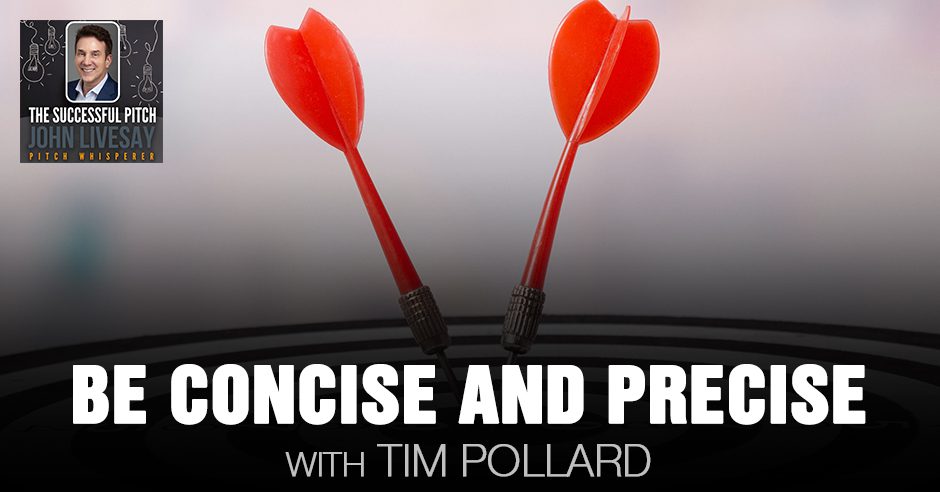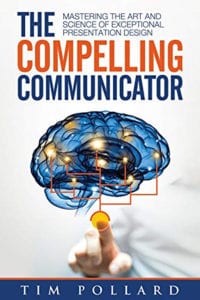Be Concise And Precise With Tim Pollard
Posted by John Livesay in podcast0 comments

The key to effective communication lies in the human brain. The brain wants and needs to consume information in a certain way. When you align with the way the brain works, you can be incredibly successful. Tim Pollard, the Founder and CEO of Oratium and the author of The Compelling Communicator: Mastering the Art and Science of Exceptional Presentation Design, joins John Livesay on the show today to explain how one can be concise and precise to become an exceptional communicator. Tim is a regular contributor to the Forbes Coaches Council and a leading thinker in advanced communication skills. He shares some insights from his experiences and journey in understanding the “science” of excellent communication and developing a holistic model for effective sales and marketing conversation. Enjoy the show and unlock the keys to get your message across to your listeners effectively.
—
Listen to the podcast here
Be Concise And Precise With Tim Pollard
Tim Pollard is the Founder and CEO of Oratium, a leading messaging consulting firm. He’s a sought after speaker and author of the acclaimed books The Compelling Communicator: Mastering the Art and Science of Exceptional Presentation Design and Mastering the Moment: Perfecting the Skills and Processes of Exceptional Presentation Delivery. Tim also draws insights from a long career in sales, marketing and communications for companies such as Unilever, Barclays Bank, and The Corporate Executive Board. I got the pleasure of seeing Tim in action. We’re in for a big treat. Tim, welcome to the show.
John, it’s a pleasure to be here. Thank you.
I know you’ve had this amazing experience and stories to share with us. Would you mind taking us back to your own story of origin? You can go back as far as you want, college, high school. When did you start to realize that you had a love of presentation, communication, and more importantly, connection?
I think I’ve had a fascination with communication almost my entire life. In the last 10 to 20 years, I’ve been particularly obsessed with understanding why does communication fail so often? When it works, why does it work? When it doesn’t work, why doesn’t it work? That led me through a very interesting journey of pursuit. It turns out that fundamentally the key to communication is one simple thought, which is it’s all about the human brain. The brain wants and needs to consume information in a certain way. When you align with the way the brain works, you can be incredibly successful, but when you misalign with the way the brain works, you’ll be incredibly unsuccessful. In nowadays world, most communication, which is dense, convoluted, complex, and PowerPoint-driven isn’t annoying, but it almost perfectly misaligns with the way the brain works. That’s one of the reasons why so much communication is ineffective.
[bctt tweet=”The left brain is about what is, and the right brain is about what things mean.” username=”John_Livesay”]
Across about the last 10 to 15 years, I invested a lot of time developing a model that would allow you to design and deliver communications to be exceptionally successful in terms of getting the outcomes you want from your audience. That draws from all kinds of weird and interesting places. There are lessons from Shakespeare. There are a lot of lessons from neuroscience and functional mapping in the brain. There are even lessons from standup comedy. All of these come together. What we did is put them all together into one holistic model that allows you to build a conversation, particularly a sales conversation and have it be much more effective. That’s how we got to where we are now.
Let’s touch on a little bit of each of those things. You got your MBA at Warwick, which is in the UK.
That’s right, close to where Shakespeare was born.
Since you mentioned Shakespeare, that was worth bringing up. You were telling me that Oratium comes from the Latin word oratur. I always like to hear the story of the origin of a company name because that’s equally important so the people have an emotional connection to it. You could have named your company anything. Ten years ago or so, you decided, “This captures what we’re going to be helping people with.”

Effective Communication: One of many new things you have to master if you’re going to sell in a virtual world is the ability to be crisply articulate, which probably was not as important in a live meeting.
Oratium is a little bit of an unusual word. It’s Latin for an oral argument. In some colleges in Europe, if you’ve done a big piece of work like a dissertation, you would do an oratium, which is your oral defense of the piece. It’s the same root word you find in orator and oratory. Our particular emphasis has always been on how do you make an oral argument? The principles of communication apply equally to written communication, letters, emails, proposals, even web design. A lot of our clients use our principles for those other nonverbal settings. A lot of what we focus on is equipping people particularly now in a virtual setting for that live sales conversations.
The other thing you said that I’m fascinated with is how you also study standup comics. Since you and I are both sales keynote speakers, we love to see what is it that makes an audience laugh. More importantly, when I’m watching Ellen DeGeneres, Jerry Seinfeld or any of them, I noticed that when they tell a story, oftentimes it’s in present tense dialogue. I wanted to get your thoughts on that.
I haven’t given a tremendous amount of thought to the tense of a story. I don’t know if it is necessarily funnier to tell it in the present tense or the past tense? Stories are better to tell it in the first person rather than the third person. People tend to engage more if they think this was an experience I had rather than something that happened to my buddy. The main lesson we’ve drawn from comedy is linguistic precision. In any presentation setting, there is an absolute premium on linguistic precision or saying something in exactly the right way, not fumbling your words, not taking 30 words to say something that could be said in ten words. Not saying something three times before you finally say it the right way. That has always been an important attribute that salespeople should cultivate, linguistic precision. That becomes geometrically more important in the virtual environment. The virtual selling environment that we’ve all found ourselves in, and that we’ve been forced into in 2020 is a much more socially-constrained environment.
Customers are more distracted. They have less bandwidth. Their actual intellectual capacity physically measurably drops. You have to get your message arrow through a narrow window. One of the ways you have to do that is with precision and economy in language. I simply don’t have the time or space to fumble around for poor, imprecise, bland language. I have to go for absolute precision. What that raises is one of many new things you have to master if you’re going to sell in a virtual world. One of them is the ability to be crisply articulate, which probably was not as important in a live meeting. I’ll give you an example. We’ve been doing some research. The average live sales meeting, you fly somewhere. You’re going to get 2.5 hours, 3 hours almost unfailingly often where lunch before or drinks afterwards.
[bctt tweet=”Create viewer anticipation when you present.” username=”John_Livesay”]
That’s very common. I was talking to IBM, Cisco, Rockwell about this. All of them are reporting meetings coming down now between 30 minutes and 45 minutes, no lunch. You’ve got a much narrower window and it’s changing the standard of precision because you don’t get to do the things you used to do in a three-hour meeting. You’ve got to be much more precise. Funnily enough, standup comedy is perhaps the nonsales discipline in society that might have best practiced that level of linguistic precision. You’ve got these interesting hyperlinks between selling and other forms of communication.
I love this concept of linguistic precision. The tweet for this episode could be, “Be concise and precise,” because that’s what you’re in essence saying.
In a virtual world, you couldn’t go too far wrong with those two premises.
One of the things you said that I was interested in at the beginning was communications is all about how our brain works. What’s the biggest mistake that you see people are making that causes them to push people away or repel them even because that’s not how our brain works, and that’s how they’re communicating?

Effective Communication: Too much sales messaging is thoroughly confusing that the value is unclear.
It’s almost hard to pick the single worst brain violation. I would say there are three. The first one is we tend to pack too much information into our messaging frequently. I look at a large technology company, the very dense, bloated, PowerPoint decks they produce. This creates complete cognitive overload. What we know from science and psychology is that once somebody feels overloaded, they ignore everything. We’re working with a large pharmaceutical company. An interesting story. The average sales meeting has got longer for pharmaceuticals, which is unusual. The reason is doctors, rather than seeing reps briefly between patients, they’re having one long sales meeting in the end. What pharmaceutical reps are doing is packing so much into that 30 minutes because they think they’re taking advantage of more time. They’re completely destroying themselves. Violating bandwidth is the most egregious problem. Death by PowerPoint and too many slides.
The second biggest brain violation is that too much sales messaging is thoroughly confusing. What I mean by confusing is the value is unclear. We do not do a good job in particular and I’ll write here the word flow, develop a good narrative story arc. We present slides with topics. The human brain does terribly badly with random information. It’s why you can’t remember a 7, 8, 9-digit phone number. I think about some of the messaging we built like with Cisco Systems, our goal here and our entire purpose is to create messaging with a logical narrative story arc. If we think about it, any great sales message is a three-part symphony. The problem you have is a customer solution, why our solution solves that problem better, and then action, how we move forward together. That macro narrative flow is a critical solution to the lack of narrative.
It’s so powerful what you said. I want to double click on that before we go to the third mistake, this confusing part. Many people love to use acronyms to try and prove how smart they are. They assume everyone else knows. What I’ve seen and I want your opinion on it is that the confused mind always says no, and the client will never let you know they’re confused. It’s up to us to read the room.
There are a lot of different places you could go with that. Any use of insider language, acronyms terminology that we understand that the customer doesn’t is an immediate fracture. We use a similar phrase. People do not buy what they don’t understand. It is hard for most people and particularly most sellers to understand what that buyer does and doesn’t know truly. For example, it’s tempting to think that if I’m selling technology and you’re buying technology, we all understand the same technological terms. That’s nonsense. If you’re a CIO of a large bank, you live in the world of banking. If I’m a seller for a technology company, I live in my world. Those two worlds are not the same. The moment you create that fracture, people are going to tune out.
[bctt tweet=”In any presentation setting, there is an absolute premium on linguistic precision, saying something in exactly the right way.” username=”John_Livesay”]
You hinted at something that is important. In a live sales meeting, you generally get to read the room. At least if you commit that mistake, you might get to correct it. In the virtual world where you have taken a thoroughly social process which is selling, and you’ve moved it now into an asocial environment. The asocial environment has three different characteristics that a seller has to understand. The customer is more distracted. The customer has less mental bandwidth. You also experience a loss of social cues. This is the one you’re talking about. When you lose social cues, you may never see that the customer was confused. Virtual selling now exists at the confluence of these three different social dynamics. If you’ve lost them for any reason, too much information, confusing, no narrative flow. There’s another piece of this that we discussed, which is your material is too technical. In the virtual environment, you may never find that out. What we know is the virtual selling environment has an amplifying effect on traditional messaging mistakes.
Three big mistakes people make because our brain is wired to learn, accept and retain information in certain ways. Without it is a disaster versus pushing out too much information, secondly is confusing them, and then the third mistake you see people making is too sender-oriented.
This is interesting because you used a particular term, which is the most extreme idea. It’s you haven’t failed to engage but you have actively got them to disengage and push you away. This is the problem of sender orientation. I got in with a story about me and I could pick up any one of these traditional slide decks. This is a 100-slide deck from a large industrial company. There is within it no single reference to a customer, a business problem, a business goal or an objective. The assumption we make often as sellers is that the customer will infer why this solution is good for them. That is entirely not good enough. At extreme, you literally have pictures of buildings, ponds and how many cool people we have and how many offices. Too much information and confusing messaging will tick people off and it’ll irritate them, but sender orientation will drive them away from you.
I could come in and talk about my great solution and they’re going to say, “Good for you. Why should I care? Why would I even be interested in this?” In a world where people are overloaded with information, the default goal is always to leave that sales conversation and do nothing. If you don’t come in with a reason why you should consider my solution, they are immediately going to default to, “Great, this meeting ended and I do not have anything on my to-do list.” Sender orientation, I’m not going to say it’s the most toxic of the three. Any one of those three will devastate a sales pursuit. These are in combination. What you see is almost all sales messages conform to these three toxic hallmarks.

Effective Communication: In a world where people are overloaded with information, the default goal is always to leave that sales conversation and do nothing.
Tim has been doing something quite unique and it’s an ability to break through the bandwidth because our brain craves new things. It’s a fight or flight response like, “Do I need to pay attention to this?” If it’s a shiny new object, we get distracted sometimes, but it also is a technique to pull people in. I’ve never seen somebody writing on a screen. How is he doing that? Your brain starts to go, “Is he writing backwards? How’s that even possible?” Please share what it is you’re doing. For those who are not able to watch, you might want to hop over to my YouTube channel and see it in action, and how this is something that you’re working with a lot of companies to help them get into this sweet spot that you were drawing those three circles of intersection.
Backing up to where you were, the brain likes variety. That’s why in any message, you need to have some degree of multimedia. I don’t mean gratuitous for the sake of it, show a video. The brain always likes you to punctuate a slide run with some white-boarding, maybe with a short video, or with some conversation. The brain craves variety. The second point is there is a particular value that has been known for a long time in sales for white-boarding or build as you go content. The reason is there are two different psychological forces that are the same thing. One is called the Gap Theory of Curiosity and one is called the Viewer Anticipation Effect. If I start drawing randomly, you suddenly want to know, “What is this? Where is he going with this?” Your brain wants to know how it ends. If I draw this three-circle model, you want to know what’s in the three.
All good communicators and particularly sales communicators should figure out where a load-bearing white-boarding moment is. The key here is not to be gratuitous. You don’t write random things. This would not be what you do. You want to make sure you’re developing load-bearing ideas and hyperlinking between them. As far as the actual technology in a live meeting, I do a lot of white-boarding but in the virtual meeting, I can do this, which is a light board. We do make and sell these because they’ve become an important communication technology. I cannot write backwards and I am not a witch. This is a pane of optical standard glass, which is weird. It’s lit from the inside, which is what’s key. As I write on it, inner lighting illuminate pigments in these special pens. The computer then flips the image. However, if that’s true, how am I able to hold something up? Post-pilot analysis, this is an interesting sales message from one of our clients. How can I hold that up and have you read that? I will let your audience figure that out for themselves.
Let’s talk about this Gap Theory a little bit and the concept of closure. I know when taking a journalism class, they were talking about how you frame yourself on camera and how you frame a story. You don’t want your head to be too high or too low from the top of the frame. Yet sometimes when people take a picture or an artist creates a painting, they won’t show the whole head because our brain completes that circle for us. I think that concept of filling in the gap, that there are a lot of ways our brain is wired to complete a circle. It pulls us in a little bit more as opposed to it being, “I’ve seen that kind of picture or painting. That’s somebody’s head.”
[bctt tweet=”The brain likes variety. That’s why in any message, you need to have some degree of multimedia.” username=”John_Livesay”]
If it’s cut up in a unique way, we don’t want to do that on virtual calls. If it is a piece of art, it’s done because our brain is craving some completion, interaction, and anticipation of imagining what is there. Let’s go into a passion of both of ours, which is storytelling and framing a story in such a way that people see themselves in your story, which in my opinion solves this big problem that I completely agree with you on which is sender orientation. That somebody is, “Here’s all about us and how long we’ve been in business,” and then you’re the person’s waiting and waiting for something relevant to them. When you craft a story of maybe another client you’ve helped or what have you, then that framework completely changes from “here’s how great we are” to a story that someone ideally can see themselves in. How do you help your client with that?
There are different themes interweaving here. Let’s break it down. As we all know and as science now knows, you have a left brain and a right brain and joined by a little bit of tissue called the corpus callosum. It’s widely misunderstood how they work. It’s not as simple as some things happen in the left and some things happen in the right. The basic understanding of the way the brain works is the left brain is good at and all about fact, detail and analysis. If you imagine a bird trying to feed, it’s looking for seeds in gravel. That would be a highly-engaged left brain. However, simultaneously the bird has to keep an eye out for predators and what it needs to do is look for patterns.
If the bird heard a squawk, saw a shadow, saw some other birds flush, the right brain puts all that together and says, “Hang on. That could be a predator.” The left brain is horrible at this. The left brain cannot do that. The right brain looks at patterns and interprets meaning. A nice phrase is the left brain looks at what something is but the right brain looks at what something means. If the left brain does the analysis, the right brain does synthesis. It’s analysis, analyzes, breaking things apart. Our right brain synthesis, putting things together. Why does this matter? All human decision-making resides in the right brain. The right brain also is the center of emotion, which is a very important part because all human decision-making is emotional by nature, not rational. It’s clearly proven by functional MRI. There’s the science background.
What all this means is when you present using a traditional sales model, we tend to present using a very left-brain, Western rationalist argument, all facts and data. Engaging the left brain, the right brain can reach over to the left brain and source left brain information for decision-making. If you want to engage a customer’s decision-making and emotional centers more directly, then you can reach into the right brain using imagery and storytelling particularly. A lot of people understand they should use story but they don’t understand why. The reason why is that you want to engage the customer’s decision-making centers, which are thoroughly right brain.

Effective Communication: The virtual selling environment is governed by an entirely different set of social rules. If you don’t understand those, they’ll destroy you.
A good way of doing that is to imagine the customer has a problem, and converting their problem into a story. Imagine you’re a doctor and you’re really tired. You’ve come off the night shift. You go and lie in the break room. You’re trying to clear your head, so you’re binge-watching Netflix on your iPad. Meanwhile, that sucking of bandwidth is preventing some key patient monitors sending signals to the nursing station and lives are being put in danger. What I did is I taught you a message we built with a technology client. I took a sterile topic, which is network bandwidth reliability and I turned it into a story. You visualize the doctor laying on the couch watching Big Bang Theory or Brooklyn Nine-Nine. You visualize maybe the baby in distress, and the nurse at his or her station not getting the signal.
Storifying a customer problem is a particularly powerful tool, and a keyword here and a critical word is the word visualize. Almost everything you’re doing as you try and engage the right brain of an audience or a customer is about helping them to visualize either their problem or your solution. We’re huge believers in storytelling as 1 of 5 tools to engage the right brain. What I’ve shown you is the underlying science and purpose behind that.
The left brain is what is and the right brain is what this means. That’s a fantastic soundbite there. Our time goes so fast with someone as knowledgeable, entertaining and insightful as you. Is there any last thought you want to leave us with before you tell us how people can find you to hire you as a speaker or if they’re interested in this amazing light board for their company?
I think probably two things. One is a lot of people don’t believe they can communicate exceptionally, whether that’s them personally or even their sales messaging. You can take any personal or corporate organizational donor message, and you can make it exceptional if you understand the structural rules of messaging that emerged from understanding the brain. We’ve seen superficially bland or uninteresting solutions converted into stellar sales messages when you apply our models. Can you have compelling, winning messaging in the market? Yes, you can.
[bctt tweet=”All human decision making is emotional by nature, not rational.” username=”John_Livesay”]
The second thing is that people have thus far completely failed to understand what’s really happened as selling has moved into the virtual environment. Most people think it’s a matter of mastering the technology. Where do I put the camera? How do I share my screen? How do I share the document? That’s total table stakes. The thing you have to wrestle with is that the virtual communication or the virtual selling environment is governed by an entirely different set of social rules. If you don’t understand those, they’ll destroy you.
Think about this. You already tend to pack too much in. What’s going to happen when you do that to somebody with less mental bandwidth? These are two trains waiting to collide. You have to understand how to communicate effectively and you have to then do that through the lens of the changes in a virtual environment. That’s what we teach companies and people how to do. It’s fascinating but if you don’t adjust to this new environment, you’re going to be in serious trouble.
I’ve always believed that whoever tells the best story in person is the one that gets the sale. Now I believe even more because you’ve given us some evidence. Whoever tells the best story and gets people to visualize themselves in that story in a virtual world is the one that’s going to stand out and leave the competition behind.
I couldn’t agree more. I’ve used that phrase, whoever tells the best story wins. That is 100% right. I would define that as the broad sales story, not a story within the sales conversation, but we’re saying the same thing. The company is Oratium. We are our Oratium.com. The website is undergoing a major revamp, which will be done fairly soon but we got contact forms there. If people want to buy the books, they can reach out to us for help if you would like.
Tim, thanks. What a pleasure. I was so impressed the first time I heard you speak and I’m equally impressed getting to know you personally and to hear your passion. It’s always so much joy for me to share this with my readers and the world when you get somebody else to validate. It’s almost like a parent relying on a friend or a teacher to tell their children something. I keep singing the same song and people believe it. Now to have somebody else singing the same song, even if it’s not necessarily being heard at the same moment by the same ears, contributes to that wonderful tipping point that book is all about. Thanks.
Likewise, it’s fun to encounter people who are like-minded. If I’m not mistaken, you did a podcast with Mr. Cialdini who talked about cross validation from different people reinforcing each other’s messaging. We are perhaps fulfilling a previous podcast.
Full circle, completing the story there about the power of edification. Thanks, Tim.
Thanks, John. See you soon.
Important Links
- Tim Pollard
- The Compelling Communicator: Mastering the Art and Science of Exceptional Presentation Design
- Mastering the Moment: Perfecting the Skills and Processes of Exceptional Presentation Delivery
- YouTube – John Livesay
- Mr. Cialdini – Past episode
- Better Selling Through Storytelling Method Online Course
Wanna Host Your Own Podcast?
Click here to see how my friends at Podetize can help
Purchase John’s new book
John Livesay, The Pitch Whisperer
Share The Show
Did you enjoy the show? I’d love it if you subscribed today and left us a 5-star review!
- Click this link
- Click on the ‘Subscribe’ button below the artwork
- Go to the ‘Ratings and Reviews’ section
- Click on ‘Write a Review’
Love the show? Subscribe, rate, review, and share!
Join The Successful Pitch community today:
- JohnLivesay.com
- John Livesay Facebook
- John Livesay Twitter
- John Livesay LinkedIn
- John Livesay YouTube
Tags: decision making, effective communication, linguistic precision, sales conversation, sales messaging, storytelling

